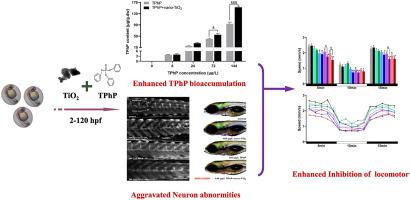Chemosphere ( IF 8.8 ) Pub Date : 2021-09-06 , DOI: 10.1016/j.chemosphere.2021.132161 Boya Fan 1 , Lili Dai 2 , Chunsheng Liu 3 , Qian Sun 1 , Liqin Yu 3

|
This study explored the combined effects of titanium dioxide nanoparticles (nano-TiO2) and triphenyl phosphate (TPhP) on the neurodevelopment of zebrafish larvae as well as the underlying mechanisms. With this regard, zebrafish embryos were exposed to nano-TiO2 of 100 μg·L−1, TPhP of 0, 8, 24, 72, and 144 μg·L−1, or their combinations until 120 h post-fertilization (hpf). Results indicated 100 μg·L−1 nano-TiO2 alone to be nontoxic to zebrafish larvae. However, obvious developmental toxicity manifested as inhibition of surviving rate, heart rate and body length as well as increased malformation was observed in the higher concentrations of TPhP (72 and 144 μg·L−1) alone and the co-exposure groups. Additionally, results suggested that nano-TiO2 significantly enhanced the bioaccumulation of TPhP in zebtafish larvae, and thus aggravated the abnormities of spontaneous movement and swimming behavior in zebrafish larvae induced by TPhP. Nano-TiO2 also exacerbated the TPhP-induced inhibition of the axonal growth on the secondary motor neuron, and aggravated the TPhP-induced decrease on expressions of neuron-specific green fluorescent protein (GFP) and neuronal marker genes (ngn1 and elavl3). Further, the content of neurotransmitter serotonin was not altered by TPhP alone exposure, but was decreased significantly in the co-exposure group of 144 μg·L−1 TPhP and nano-TiO2. Our data indicated that nano-TiO2 might aggravate the neuron abnormities and serotonin system dysfunction by enhancing the TPhP accumulation, leading to exacerbated abnormal locomotors in zebrafish larvae.
中文翻译:

纳米二氧化钛加剧磷酸三苯酯在斑马鱼幼虫体内的生物积累和发育神经毒性
本研究探讨二氧化钛纳米颗粒(纳米TiO 2的组合效果2对斑马鱼幼体以及底层机制的神经发育)和磷酸三苯酯(TPhP)。关于这一点,斑马鱼胚胎暴露于纳米的TiO 2 100微克·L -1,的TPhP 0,8,24,72,和144微克·L -1,或它们的组合,直到120小时后受精(HPF )。结果表明单独使用100 μg·L -1纳米TiO 2对斑马鱼幼虫无毒。然而,在较高浓度的TPhP(72和144 μg·L -1) 单独和共同暴露组。此外,结果表明纳米TiO 2显着增强了斑马鱼幼体TPhP的生物积累,从而加剧了TPhP诱导的斑马鱼幼体自发运动和游泳行为的异常。Nano-TiO 2还加剧了TPhP诱导的次级运动神经元轴突生长的抑制,并加剧了TPhP诱导的神经元特异性绿色荧光蛋白(GFP)和神经元标记基因(ngn1和elavl3)表达的降低。此外,单独暴露TPhP并没有改变神经递质5-羟色胺的含量,但在144 μg·L -1 TPhP和纳米TiO的共暴露组中显着降低2 . 我们的数据表明纳米TiO 2可能通过增加TPhP的积累而加重神经元异常和血清素系统功能障碍,导致斑马鱼幼虫运动异常加剧。



























 京公网安备 11010802027423号
京公网安备 11010802027423号